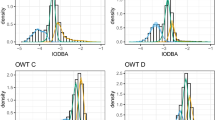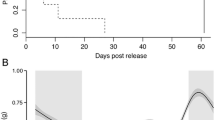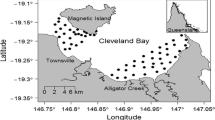Summary
Movement patterns of scalloped hammerhead sharks in the vicinity of El Bajo Espiritu Santo, a seamount in the Gulf of California, were determined by tracking by ultrasonic telemetry 13 sharks and marking 100 sharks. The 13 tracked sharks swam back and forth along the seamount ridge throughout the day. They did not swim in different directions to reduce swimming effort when currents changed from a parallel to a perpendicular orientation to the ridge. Sharks tracked up to 8 km away into the pelagic environment soon returned to the seamount. From such trackings and repeated observations of marked sharks over periods of several weeks, it is believed that most sharks disperse and return to the seamount in a rhythmical fashion. The separate departures of individual hammerheads in five paired trackings indicated that the sharks left the seamount either in small groups or singly. For these reasons, we argue that the social system of the scalloped hammerhead shark can be described as a refuging system.
Similar content being viewed by others
References
Batschelet E (1965) Statistical methods for the analysis of problems in animal orientation and certain biological rhythms. A.I.B.S. Monograph, American Institute for Biological Sciences, Washington
Hamilton WJ, Watt KE (1970) Refuging. In: Johnston RF, Frank PW, Michener CD (eds) Annu Rev Ecol Syst 1:263–287
Hayne DW (1949) Calculation of size of home range. J Mammal 39:190–206
Johnson RH (1978) Sharks of polynesia. Les Editions de Pacifique, Papeete
Klimley AP (1982a) Grouping behavior in the scalloped hammerhead. Oceanus 24:65–71
Klimley AP (1982 b) Social organization of schools of the scalloped hammerhead, Sphyrna lewini (Griffith and Smith), in the Gulf of California. Dissertation, University of California
Klimley AP, Nelson DR (1981) Schooling of the scalloped hammerhead shark, Sphyrna lewini, in the Gulf of California. Fish Bull 79:356–360
McLaughlin RH, O'Gower AK (1971) Life history of underwater activities of a heterodont shark. Ecol Monogr 41:271–289
Nelson DR, Johnson RH (1980) Behavior of the reef sharks of Rangiroa, French Polynesia. Natl Geogr Res Rep 12:479–499
Nelson DR, McKibben JN (1981) Time release, recoverable ultrasonic/radio transmitter for tracking pelagic sharks. In: Long PM (ed) Proceedings of the third international conference of wildlife biotelemetry. ICWB, Laramie pp 90–104
Randall JE (1977) Contribution to the biology of the whitetip reef shark (Triaenodon obesus). Pac Sci 3:145–164
Southwood TRE (1978) Ecological methods. Wiley, New York
Author information
Authors and Affiliations
Rights and permissions
About this article
Cite this article
Klimley, A.P., Nelson, D.R. Diel movement patterns of the scalloped hammerhead shark (Sphyrna lewini) in relation to El Bajo Espiritu Santo: a refuging central-position social system. Behav Ecol Sociobiol 15, 45–54 (1984). https://doi.org/10.1007/BF00310214
Received:
Accepted:
Issue Date:
DOI: https://doi.org/10.1007/BF00310214




